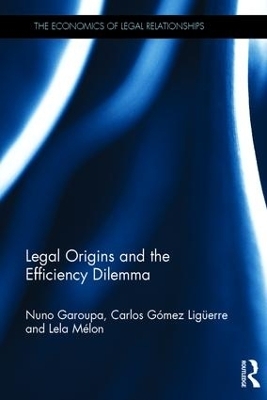
Legal Origins and the Efficiency Dilemma
Routledge (Verlag)
978-1-138-23287-7 (ISBN)
Legal Origins and the Efficiency Dilemma has six aims: explaining the efficiency hypothesis of the common law since Posner’s 1973 book; summarizing the legal origins theory in the context of economic growth; debunking their relationship; discussing the meaning of 'common law' and the problems with the efficiency hypothesis by comparing laws across English speaking jurisdictions; illustrating the shortcomings of the legal origins theory with a comparative law and economics analysis; and concluding there is no theory and evidence to support the economic superiority of common law systems. Based on previous pieces by the authors, this book expands their work by including new areas of analysis (such as trusts), detailing previous analysis (such as French law versus common law in the areas of contract, property and torts), and updating for recent developments in the academic discourse.
This volume is of interest to academics and students who study microeconomics, comparative law and foundations of law, as well as legal policy analysts.
Nuno Garoupa is Professor of Law at Texas A&M University, School of Law, and holds the Chair in Research Innovation at Católica Global School of Law, Lisbon, Portugal. Carlos Gómez Ligüerre is Professor of Private Law at the Pompeu Fabra University (Universitat Pompeu Fabra), Barcelona, Spain. Lela Mélon is Adjunct Professor of Law at the Pompeu Fabra University (Universitat Pompeu Fabra), Barcelona, Spain.
List of illustrations
Acknowledgments
PART I: Legal origins in a nutshell – inherent dangers of its blind acceptance
1 Introduction
2 The danger of a globally accepted theory containing major flaws
3 The efficiency of the common law hypothesis
4 Legal origins: the comparative perspective
5 The evolution of the common law and efficiency: what is the meaning of common law?
Why efficient common law
Tort law
Defamation law
Professional responsibility
Cost rules in civil litigation
Civil juries
Brief examples to guide to more detailed overviews
PART II: Piercing the veil – application of legal origins to specific legal institutes
6 Contrasting common and civil law: private law
Bona fide purchase
Titling of property
Principle of non-cumul in torts and contracts
The Good Samaritan Rule
7 Contrasting common and civil law: legal governance and the specialization of courts
The model
Administrative courts
Commercial courts
Constitutional courts
8 The puzzle of mixed law jurisdictions
Contrasting common and civil law: the role of trusts and mixed legal jurisdictions
PART III: Modern dilemmas in US and EU law as representatives of the two distinct legal families
9 Contrasting civil and common law: the area of intellectual property
Why intellectual property law?
On intellectual property
How are the US and the EU approaching the field?
Efficiency of trademark protection in common and civil law systems
Geographic indications
Patent protection in the US and EU
The efficiency of the ‘fair use’ doctrine under the conditions of two distinct copyright law systems
10 Contrasting common and civil law: corporate law in the US and EU
Inherent flaws of the legal origins in researching the field of corporate law: the taxonomy of countries
Inherent flaws of the legal origins in researching the field of corporate law: coding errors
The inherent dangers of the persisting influence of legal origins theory on the international level
The US and EU: legal origins and individual institutes in US and EU corporate laws
Bibliography
Index
| Erscheinungsdatum | 12.03.2017 |
|---|---|
| Reihe/Serie | The Economics of Legal Relationships |
| Zusatzinfo | 4 Tables, black and white; 2 Line drawings, black and white; 2 Illustrations, black and white |
| Verlagsort | London |
| Sprache | englisch |
| Maße | 156 x 234 mm |
| Gewicht | 430 g |
| Themenwelt | Recht / Steuern ► EU / Internationales Recht |
| Recht / Steuern ► Wirtschaftsrecht ► Handelsrecht | |
| Recht / Steuern ► Wirtschaftsrecht ► Urheberrecht | |
| Wirtschaft ► Volkswirtschaftslehre ► Mikroökonomie | |
| ISBN-10 | 1-138-23287-4 / 1138232874 |
| ISBN-13 | 978-1-138-23287-7 / 9781138232877 |
| Zustand | Neuware |
| Haben Sie eine Frage zum Produkt? |
aus dem Bereich


